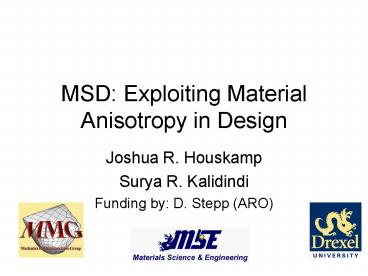MSD: Exploiting Material Anisotropy in Design PowerPoint PPT Presentation
1 / 16
Title: MSD: Exploiting Material Anisotropy in Design
1
MSD Exploiting Material Anisotropy in Design
- Joshua R. Houskamp
- Surya R. Kalidindi
- Funding by D. Stepp (ARO)
2
Complete Product Design
- Product
- Component
- Microstructure
- Nanostructures
NASA
3
Current Design Method
- Typically Materials Selection and Geometry
Optimization - Materials thoroughly characterized to meet
material specifications - Geometry Optimization through FEM
Database Materials Selection
Iterative design
4
Anisotropy
Optical properties
Mechanical properties
Magnetic properties
Experimentally measured anisotropy magnetic
fields from nanomagnets
Source D.K. Koltsov
5
Novel Methods of Engineering Design
- Topology Optimization
- Spatial arrangement of materials with different
(isotropic) properties with void space - a, k, snap-fit connectors, injection molding
platens - Torquato(1997), Sigmund (1994, 1997)
- Systems approach Materials by Design
- collection of forward problems linked empirically
- Steel, aluminum, shape memory alloys
- Olsen (1997,2000), QuesTek
- Drawbacks
- Not rigorously bounded design space
- Non-convex design space
- Non-unique solutions
- No Consideration of anisotropy at the local state
6
Fundamental Problems in Materials Design
- Can we identify the complete set of
microstructures that are predicted to yield a
specific combination of properties? - Can we identify processing routes to achieve the
identified microstructures?
7
Problem Statement
- Made with a continuously reinforced fibrous
composite - What is the best fiber orientation distribution
to maximize load carrying capacity?
8
Microstructure Representation
Symmetry Requirements
9
Microstructure Hull Composites
10
Two Level Homogenization Composites
- Meso-scale Homogenization scheme
- Single Lamina
- Rule of mixtures type homogenization
- Macroscale Homogenization
- Weighted Volume average
- of individual plys
Subject to
11
Property Closures Composites
a 0.5
12
Circular hole in a plate
- Potential factor of improvement of up 4
- Conservatively, based on (WAM) property
estimates, design is improved by a factor of 2
13
Extension to Polycrystalline Metals
- Consider polycrystalline metals 3D Composites
- Consequently
Bunge, H.-J., Texture analysis in materials
science. Mathematical Methods. 1993, Göttingen
Cuvillier Verlag.
14
Results
15
Conclusions
- Case study shows an enriched design space when
local anisotropy considered - MSD identifies a class of microstructures that
provide a similar performance metric - Accuracy of solutions is dependant on truncation
of Fourier series - MSD may be readily applied several classes of
materials with differing symmetries
16
Current Standings
- Ph.D. Completion Summer of 2005
- Currently interviewing for Post Doctoral
positions at Army Research Labs, Aberdeen, MD

